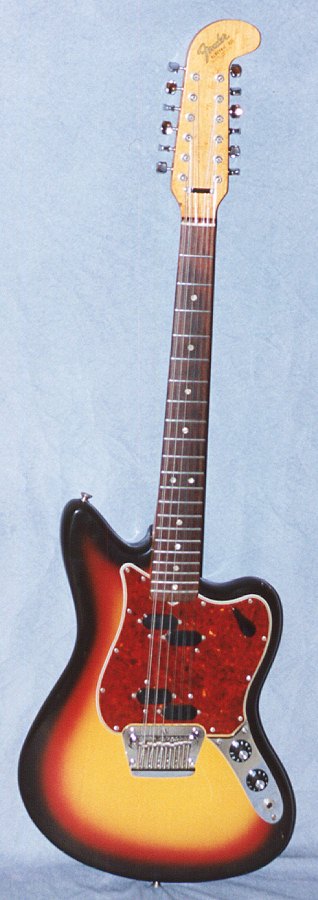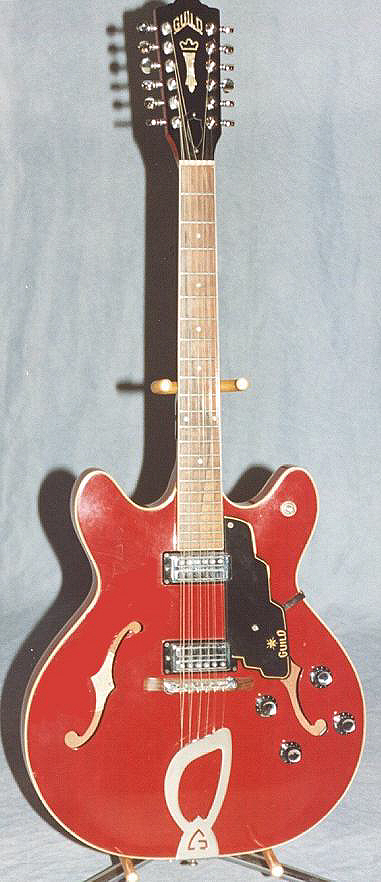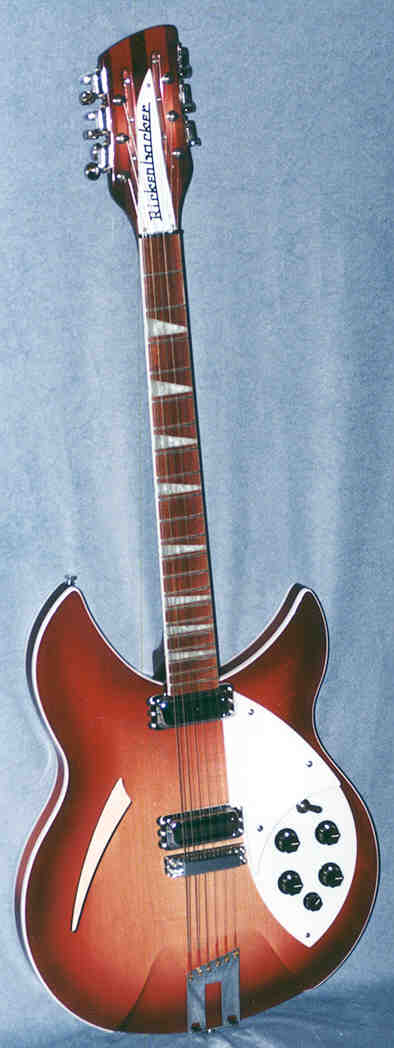Showdown: Electric 12-String Guitars
by Greg Gagliano
Copyright 1997, 20th
Century Guitar Magazine
The use of 12-string electrics in mainstream rock can pretty much be traced
to George Harrison of the Beatles. After seeing George Harrison play
a Rickenbacker 12-string in the film "A Hard Day's Night," Jim (later Roger)
McGuinn of the Byrds immediately ran out and bought one. The rest,
as they say, is history. Most electric 12-string players owe a debt
to Jim/Roger McGuinn, including the Beatles themselves, who went back and
copied the Byrd's sound during their "Rubber Soul" and "Revolver" period,
most obviously on the song "Rain."
Besides the Byrds, the Beatles, and the Hollies, The Turtles copped McGuinn's
sound for "It Ain't Me Babe" as did The Searchers on “Needles and Pins.”
Richie Furay of the Buffalo Springfield was seen holding a Gibson ES-335-12
around 1966 and Mike Nesmith of The Monkees played a Gretsch 6076.
Tim Buckley sometimes played a solid-body electric 12-string in addition
to his acoustic 12-string, Jimmy Page played a Gibson 6/12 doubleneck and
a Fender Electric XII, and Lou Reed of the Velvet Underground played mostly
12-string on their third album. Brian Jones of the Rolling Stones reportedly
used a Rickenbacker 12-string on the “High Tide and Green Grass” album, and
even Alex Volpe of the Silver Skunks used a semi-hollow, teardrop body, cherry
sunburst Vox 12-string with built-in E-tuner.
More recent artists that use electric 12-strings include Tom Petty (McGuinn's
musical godson), Robyn Hitchcock (eccentric English popster), Pete Kennedy
(former Nashville sideman, now performing as a duo with wife Maura), and
Arto Lindsay (difficult to describe).
In 1965, the folk rock boom was well underway and by 1966, nearly all the
major guitar makers such as Fender, Gibson, Rickenbacker, Danelectro, Vox,
Hagstrom, Gretsch and Guild, offered an electric 12-string model. However,
electric 12-strings quickly faded from the marketplace as the folk rock boom
waned.
This month’s “Showdown” will slice and dice a 1966 Fender Electric XII,
a circa 1966 Danelectro Bellzouki, a 1966 Guild Starfire XII, a recent Charvel
Surfcaster, and a 1966 Rickenbacker 360-12. Of course, I played the
requisite “Turn, Turn, Turn” on each one which provided a very useful benchmark
when comparing them.
 The Fender Electric XII was introduced in 1965 with the bulk of the production
taking place in 1966 before it was discontinued around 1970. Like
all the 12-strings in this comparison, it was relatively short-lived.
The Electric XII sports an alder, offset contour body that is similar in
appearance to the Bass VI, Jaguar and Jazzmaster. The bolt-on 1-piece
maple neck is topped by a rosewood board with dot markers. The headstock
was a departure from Fender’s usual Stratocaster-style shape and is sometimes
referred to as the “hockey stick” headstock.
The Fender Electric XII was introduced in 1965 with the bulk of the production
taking place in 1966 before it was discontinued around 1970. Like
all the 12-strings in this comparison, it was relatively short-lived.
The Electric XII sports an alder, offset contour body that is similar in
appearance to the Bass VI, Jaguar and Jazzmaster. The bolt-on 1-piece
maple neck is topped by a rosewood board with dot markers. The headstock
was a departure from Fender’s usual Stratocaster-style shape and is sometimes
referred to as the “hockey stick” headstock.
Leo Fender’s bridge design for this model is elegantly simple and works
extremely well. There is an individual saddle for each string making
precise intonation possible. The design is also string-through-body
which helps to increase sustain. The string guide on the headstock
is clever, as well. Instead of using a simple bracket, Leo took a solid
block of metal and drilled 12 individual holes in it as a string guide.
The electronics consist of two split-coil pickups, similar to the ones found
on the Mustang Bass, a 4-way rotary pickup selector switch, a master volume,
and a master tone control.
Playing the Electric XII feels instantly familiar for anyone used to playing
mid-1960s Jazzmasters. The neck profile is quite oval in shape with
a 7.5 inch radius fingerboard and 25 1/2 inch scale length. The 1
5/8 inch nut width can make the player’s left hand feel a little cramped
at times. The guitar is well balanced sitting or standing. Sonically,
the Electric XII has typical Fender single coil tone (bright, bell-like)
and is quite versatile, from treble thin, to biting jangle, to warm and smooth.
The Danelectro Bellzouki, Model 7010, was introduced in the early 1960s
and the example here dates circa 1966. It has a teardrop-shaped body
composed of a poplar frame with 1/8 inch masonite covering. The truss
rod reinforced, bolt-on maple neck is capped by a Brazilian rosewood fingerboard
with an aluminum nut. The bridge is the typical Dano chrome steel plate
with straight, non-adjustable rosewood saddle. The electronics consist
of one “lipstick tube” single coil pickup, a 3-way toggle for tone selection,
a master volume and a master tone control.
The Dano is impossible to play sitting unless a shoulder strap is used.
The teardrop body simply slides off the player’s thigh. Of course,
smart Dano players use the 2-pickup Bellzouki Model 7020 which has a 4-point
tear drop sculpted body. The body shape on this model is more amenable
to playing while sitting. The neck profile on the Bellzouki is nicely
oval and the fingerboard radius quite flat. The nut width is also wider
than any of the other guitars in this comparison which, when combined with
the 24 1/2 inch scale length, makes playing a bit easier while not being
a chore as on some acoustic 12-string guitars.
The lipstick tube pickup yields a wonderfully complex sound. It’s
bright, but it doesn’t jangle the eardrums and nerves quite as much as the
other models. The tone control toggle’s effect on the guitar’s sound
is subtle and does not provide much tone shaping. The master tone
knob is more effective. With only one pickup, the Dano is the least
versatile of the bunch, but the rich sound more than makes up for any shortcoming
in that area. It’s amazing that a guitar so “cheap” can sound so very
good.
 Guild’s entry into the foray is the Starfire XII which was introduced in
late 1965. The bulk of the Starfire XIIs were made in 1966 and 1967
with very few being made in subsequent years until the model was discontinued
in 1974. Unlike the purpose-built 12-string guitars by Fender, and
Danelectro, Guild took its cue from Rickenbacker and Gibson by simply used
an existing 6-string model as the platform for a 12-string model.
Guild’s entry into the foray is the Starfire XII which was introduced in
late 1965. The bulk of the Starfire XIIs were made in 1966 and 1967
with very few being made in subsequent years until the model was discontinued
in 1974. Unlike the purpose-built 12-string guitars by Fender, and
Danelectro, Guild took its cue from Rickenbacker and Gibson by simply used
an existing 6-string model as the platform for a 12-string model.
The Starfire XII shown here hails from 1966 and has a double cutaway, laminated
mahogany, semi-hollow body. It has a 3-piece mahogany/maple neck topped
by a bound rosewood fingerboard. The bridge is a typical archtop-style
rosewood unit with a compensated saddle. The guitar pictured here has
an aftermarket adjustamatic type bridge which is superior for intonation.
The strings are secured by Guild’s trademark harp trapeze tailpiece.
The Starfire XII uses a pair of Guild humbucking pickups run through the
traditional arrangement of separate volume and tone controls for each pickup.
A 3-way toggle switch selects pickup configuration.
The neck profile is very similar to the Fender’s, though the Guild has
a shorter scale length of 24 3/4 inches. Like the Fender it has a 1
5/8 inch nut width and is easy to play, but can feel even more cramped at
times due to the shorter scale.
The guitar is well balanced and equally comfortable to play while sitting
or standing. The Guild humbuckers provide the player with excellent
“Turn, Turn, Turn” jangle and killer jazz tone. The two pickups in
combination produce a more diffuse, “out-of-phase” sound. And if you’re
wondering about the jazz tone... I played a little riff on this guitar for
a friend who remarked that it sounded very much like chorus effects that a
lot of modern jazz guitarists are using, but that sound is “built in” to this
guitar.
The Charvel Surfcaster 12-string is the only modern guitar in this comparison.
Having been made in Japan, it is also the only non-American guitar, as well.
The design is a hybrid influenced by Rickenbacker (headstock, semi-hollow
f-hole body, triangle inlays), Fender (Jaguar/Jazzmaster body shape) and
Danelectro (pickups). It has a mahogany, semi-hollow body with a 2-piece
flame maple top. The neck is constructed of 2 pieces maple topped
by a bound ebony fingerboard. The bridge is really neat. It’s
a cast metal unit with a single, compensated saddle for each string, meaning
perfect intonation is not possible. However, the octave strings of
each pair are strung through the body, but the fundamental strings are bridge
strung.
The Surfcaster uses a pair of single coil “lipstick tube” pickups.
The controls consist of master volume and master tone with phase switch.
A 3-way toggle switch selects pickup configuration.
The neck profile is flattened oval with a fairly flat fingerboard fitted
with jumbo frets. The scale length 25 1/2 inches with a 1 5/8 inch
nut width. It is easy to play, but can still feel cramped at times due
to the standard 6-string nut width.
The guitar is well balanced and comfortable to play. The Charvel
provides the player with the most versatile tonal selection of any of the
guitars compared here. It can produce bright bell tones, it can be
warm and smooth, and it can even sound “six stringy” if you want.
 Enter the Rickenbacker which is acknowledged by most players as the Mother
of All Electric 12-Strings. The 330-12 has a semi-hollow maple body
with set-in neck construction. The neck is maple/walnut laminate topped
by a bound rosewood fingerboard. The neck is narrow and has an oval
profile. The headstock has a unique design which allows for a more
compact shape. The tuners are placed in an alternating sequence of
standard and slot configuration. The slot head tuners are a pain in
the neck to string up.
Enter the Rickenbacker which is acknowledged by most players as the Mother
of All Electric 12-Strings. The 330-12 has a semi-hollow maple body
with set-in neck construction. The neck is maple/walnut laminate topped
by a bound rosewood fingerboard. The neck is narrow and has an oval
profile. The headstock has a unique design which allows for a more
compact shape. The tuners are placed in an alternating sequence of
standard and slot configuration. The slot head tuners are a pain in
the neck to string up.
The strings ride over an adjustamatic type bridge and are held by a stylized
“R” trapeze tailpiece that competes with the Guild for the Tailpiece Elegance
Award. The Ric uses a pair of single coil “toaster” pickups.
These pickups, along with the reversal of the traditional 12-string stringing,
produce the classic Rickenbacker 12-string sound.
Controls consist of a volume and tone control for each pickup, a 3-way
pickup selector switch and a pan control for the stereo output. Yes
that’s right, this ‘66 has the venerable Ric-O-Sound stereo output system,
though I tested it in mono mode.
At first, the guitar seems easy to play, but like the other 12-strings
in this comparison, the Rickenbacker’s neck is too narrow. But the
difficult playability is more than compensated by the classic sound.
Andy Sandler, the Ric’s owner, played a Beatles/Byrds/Tom Petty medley using
the 360-12 and a ‘64 Vox AC-30. It was a religious experience.
No other 12-string sounds like this combination of Rickenbacker and Vox.
All of these guitars sound great and are formidable instruments in a solo
or group setting. No one of these guitars is better than the other,
they are just different. They are all well made, with quality materials
and workmanship, though the Dano is on the outer fringe of this statement.
Be aware, however, that electric twelves with their light gauge strings
can be a tuning nightmare... especially during a gig.
Which guitar I liked the best shouldn’t affect your decision to play or
own one of these guitars. But, for what it’s worth, I liked the Danelectro
the best for the playability of its slightly wider neck and excellent, smooth
tone. However, the teardrop body made me insane. If I wanted
the quintessential electric 12-string sound, then it’s the Ric all the way
despite its skinny neck.
Electric 12-string guitars have their place in rock and roll history as
well as in modern rock. Their sound is distinctive and their Jangle
Power can clear the sinuses of even chronic allergy sufferers during the
peak of ragweed season. As Silver Skunk guitarist Alex Volpe noted:
“The closest I ever came to going deaf was at a concert with The Byrds when
Clarence White was in the band. Both he and McGuinn had their respective
Tele and Ric set to ‘Full Ultra Treble Stun with Malicious Intent to Inflict
Auditory Canal Damage.’ I had to have the doctor check my ears a week
later, but it was worth it. They killed!”
Thanks to Jim Strahm and Matt Kesler at Midwestern Musical Co., Mission,
Kansas for providing the Fender and Danelectro, to Andy Sandler for loaning
his Rickenbacker, and to Dan Miller at Guitar Source, Overland Park, Kansas
for providing the Charvel for this comparison. Special thanks to Dan
Segal M.L.S., the human encyclopedia of musical knowledge, for his assistance.
About the author: Greg Gagliano’s cochlear nerve, tympanic membrane,
stapes, malleus, and incus have not been the same since playing the Guild
Starfire XII through an Ampeg V-4 half stack with the volume control set
to 7 “just to see how it would sound.”
Back to GGJaguar's Bibliography
 The Fender Electric XII was introduced in 1965 with the bulk of the production
taking place in 1966 before it was discontinued around 1970. Like
all the 12-strings in this comparison, it was relatively short-lived.
The Electric XII sports an alder, offset contour body that is similar in
appearance to the Bass VI, Jaguar and Jazzmaster. The bolt-on 1-piece
maple neck is topped by a rosewood board with dot markers. The headstock
was a departure from Fender’s usual Stratocaster-style shape and is sometimes
referred to as the “hockey stick” headstock.
The Fender Electric XII was introduced in 1965 with the bulk of the production
taking place in 1966 before it was discontinued around 1970. Like
all the 12-strings in this comparison, it was relatively short-lived.
The Electric XII sports an alder, offset contour body that is similar in
appearance to the Bass VI, Jaguar and Jazzmaster. The bolt-on 1-piece
maple neck is topped by a rosewood board with dot markers. The headstock
was a departure from Fender’s usual Stratocaster-style shape and is sometimes
referred to as the “hockey stick” headstock.  Guild’s entry into the foray is the Starfire XII which was introduced in
late 1965. The bulk of the Starfire XIIs were made in 1966 and 1967
with very few being made in subsequent years until the model was discontinued
in 1974. Unlike the purpose-built 12-string guitars by Fender, and
Danelectro, Guild took its cue from Rickenbacker and Gibson by simply used
an existing 6-string model as the platform for a 12-string model.
Guild’s entry into the foray is the Starfire XII which was introduced in
late 1965. The bulk of the Starfire XIIs were made in 1966 and 1967
with very few being made in subsequent years until the model was discontinued
in 1974. Unlike the purpose-built 12-string guitars by Fender, and
Danelectro, Guild took its cue from Rickenbacker and Gibson by simply used
an existing 6-string model as the platform for a 12-string model.  Enter the Rickenbacker which is acknowledged by most players as the Mother
of All Electric 12-Strings. The 330-12 has a semi-hollow maple body
with set-in neck construction. The neck is maple/walnut laminate topped
by a bound rosewood fingerboard. The neck is narrow and has an oval
profile. The headstock has a unique design which allows for a more
compact shape. The tuners are placed in an alternating sequence of
standard and slot configuration. The slot head tuners are a pain in
the neck to string up.
Enter the Rickenbacker which is acknowledged by most players as the Mother
of All Electric 12-Strings. The 330-12 has a semi-hollow maple body
with set-in neck construction. The neck is maple/walnut laminate topped
by a bound rosewood fingerboard. The neck is narrow and has an oval
profile. The headstock has a unique design which allows for a more
compact shape. The tuners are placed in an alternating sequence of
standard and slot configuration. The slot head tuners are a pain in
the neck to string up.